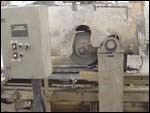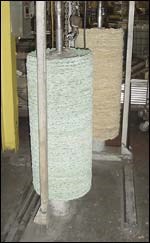Better (and Safer) Buffing Through Chemistry
A switch to non-combustible compounds and pads eliminated a potentially explosive situation at a Loxcreen Aluminum Division plant...
Founded in 1947, Loxcreen Co. Inc. is a supplier of custom aluminum and vinyl extrusions, standard extrusions, coil, stainless steel, floor trim, and building products. The company is headquartered in West Columbia, SC, and has manufacturing and distribution facilities in seven states.
Loxcreen’s Aluminum Division operates plants in Hayti, MO, and Roxboro, NC, producing 6,000-Series aluminum alloy extrusions with maximum width up to eight inches. Fabrication capabilities include sawing, mitering, punching, drilling, bending, welding, stamping cold-roll forming and slitting.
The plants apply a variety of finishes to its extruded products in lengths up to 30 ft. These include electrostatic paint, multiple clear and colored anodizing and other processes. In the company’s two-step electrolytic coloring process, for example, the extrusion is clear anodized using conventional sulfuric anodizing, then color is electrolytically deposited into anodic pores to produce colors ranging from champagne to black.
An integral part of producing some of the 11 available finishes is buffing. Loxcreen operates four buffing lines at the 135,000-sq-ft Roxboro plant.
Steve James, VP and general manager of Loxcreen’s Aluminum Division, explains that a typical buffing line consists of a table that traverses back and forth under a wheel. The wheel sits at the center of a dust collection hood. Buffing compound is applied to the aluminum extrusions. Buffing may require anywhere from one to seven passes of the table under the wheel. Typical cycle time for the operation is roughly three minutes.
Buffing wheels are consumable items with service life of one to three days. As they are used, they generate dust and swarf that Loxcreen collects for disposal. A wet dust collection system handles residue from the company’s Buffer 1. Residue from Buffers 2 and 3 is directed to a combined dry dust collection system and residue from Buffer 4 is handled by a separate dry dust collection system.
The dry collectors for Buffers 2, 3 and 4 collect anywhere from 20-40 lb of material per buffer per day while processing 3,000-9,000 lb of extruded aluminum. Dust consists largely of buffing pad material and compound, with small aluminum content.
Loxcreen also performs brushing with two machines. The operation typically uses a belt or wheel impregnated with abrasive particles. Brushing uses no compound and dust generated is typically high in aluminum content.
Potential Hazards
Loxcreen managers were aware of the potential hazards of buffing and brushing from an employee hygiene and safety standpoint. The company provided hearing protection and dust masks for workers, kept material safety data sheets (MSDS) for all compounds and wheels and guarded against other potential hazards.
In 2003, however, managers became aware of another potential hazard. A dust explosion at a nearby North Carolina pharmaceutical plant resulted in seven fatalities and more than 30 serious injuries. In a routine visit from the North Carolina Occupational Safety and Health Administration (NCOSHA) shortly after this explosion, inspectors pointed to dust in Loxcreen’s buffing room as a potential explosion hazard.
Neither OSHA nor the U.S. Environmental Protection Agency’s (EPA) Risk Management Program (RMP) standard provides specific requirements for handling aluminum dust or controlling dust explosion hazards. But the documents require that employers provide “a safe place to work,” and that companies should follow available consensus standards to manage potential workplace hazards.
Several such standards developed by the National Fire Protection Association (NFPA) apply for handling of aluminum dust and other particulates. One, NFPA 499, provides a method for classifying combustible dusts. The test method involves comparing several characteristics of the test material—conductivity, ignition sensitivity, explosion severity, minimum explosive content (MEC), minimum ignition energy (MIE) and ignition temperature—with data from Pittsburgh seam coal dust.
Dusts with an Ignition Sensitivity rating of <0.2 are unclassified, but dusts with Ignition Sensitivities from 0.2 to 5.0 are deemed hazardous and classified as Class II combustible. If dust is classified as Class II, it requires remediation ranging from tight controls in the immediate vicinity to a total explosion-proof environment.
| TABLE I: NFPA 499 Dust Classification Criteria | |||
| Degree of Hazard Severity | Ignition Sensitivity | Explosion Severity | Dust Classification |
| Weak | <0.2 | <0.5 | Not Classified |
| Moderate | 0.2-1.0 | 0.5-1.0 | Class II Combustible |
| Strong | 1.0-5.0 | 1.0-2.0 | Class II Combustible |
| Severe | >5.0 | >2.0 | Class II Combustible |
Dust Testing
Analysis of Loxcreen’s buffing and brushing dusts by an independent laboratory—Kidde-Fenwal’s Combustion Research Center (CRC) in Holliston, MA—indicated that the buffing dust consisted of a non-conductive, combustible mixture of cotton, buffing compound and 5.6% of aluminum dust. Brushing dust consisted of about 65% aluminum and was conductive and combustible.
Based on test results, both dusts were identified as NFPA 499 Class II. In the brushing area, all equipment would have to be made explosion-proof. The buffing area would require explosion-proof equipment within 10 ft of the buffing machines.
“The cost of making our buffing and brushing operations explosion-proof would have been a death sentence,” James recalls. “The calculated cost for all lights, motors, starters, electrical controls, conduit, and other modifications was in excess of $250,000.”
Possible alternatives to providing explosion-proof equipment included staying below the minimum explosive content, reducing oxygen concentration, removing potential ignition sources, providing explosion containment and suppression, and venting.
Compound Change
In the buffing area, Loxcreen managers chose to lower ignition sensitivity by adding inert material to the buffing compounds. They worked with two potential suppliers, eventually settling on Schaffner Mfg. Co., Inc. (Pittsburgh), a supplier of buffing wheels and compounds, to develop non-combustible compounds for their application.
“Alternatives were very expensive,” James says. “Flame retardant compounds and buffing pads cost only a couple percent more than conventional compounds and pads. And, there was no impact on the operation itself.”
Schaffner says its patented Fire Chief buffing wheels and compound are the only buff and compound combination that can alter the properties of buffing swarf from Class II combustible to non-classified according to testing done at the Combustion Research Center and NFPA guidelines. The company says neither wheels, compound, or swarf will support a flame.
| TABLE 2: Test Results on Sieved and Dried Buffing Residue | |||||
| Buffing Pad |
No Flame Retardant | Flame Retardant | Schaffner Retardant, Level A | Schaffner Retardant, Level B | Schaffner Retardant, Level C |
|
Buffing Compound |
No Retardant | No Retardant | No Retardant | No Retardant |
Schaffner Retardant |
|
Ignition Sensitivity |
0.94 | 0.29 | 0.27 | 0.16 | 0.05 |
|
Explosion Severity |
0.18 | 0.17 | 0.17 | 0.34 | 0.13 |
|
Minimum Explosive Content |
375 | 650 | 233 | 288 | 375 |
|
Minimum Ignition Energy |
34 | 48 | 163 | 196 | 452 |
| Ignition Temperature | 350 | 465 | 405 | 450 | 513 |
| Dust Classification | Class II Combustible | Class II Combustible | Class II Combustible | Not Classified |
Not Classified |
After several experiments with varying additive percentages in the compound and wheels, the company hit on a method to achieve passing results. Buffing dust is now not classified, and is subject only to good housekeeping.
Brushing Fix
Bringing the brushing operation with its high-aluminum dust into compliance proved more difficult. No flame-retardant additive worked, and isolation/explosion proofing of the brushing machines would have cost in the range of $30,000 per machine.
Loxcreen initially set up a spiral brushing machine outdoors and performed the operation on days with good weather. The longer-term fix for the brushing operation turned out to be enclosing the machine and surrounding area, a total of roughly 300 sq ft.
“We couldn’t have lighting fixtures or anything in the room unless they were explosion-proof, so we basically built the top half of the room out of plexiglass so that lights outside the room could provide lighting,” James recalls. “We had to buy a couple of pumps, and we put positive pressure in electrical boxes using compressed air to keep dust out.”
According to James, the enclosure and other changes needed in the brushing area cost nearly $45,000. No Loxcreen personnel work regularly in the room, and maintenance personnel follow specific procedures when servicing equipment in the enclosure, he adds.
Read Next
Education Bringing Cleaning to Machining
Debuting new speakers and cleaning technology content during this half-day workshop co-located with IMTS 2024.
Read MoreEpisode 45: An Interview with Chandler Mancuso, MacDermid Envio Solutions
Chandler Mancuso, technical director with MacDermid Envio discusses updating your wastewater treatment system and implementing materials recycling solutions to increase efficiencies, control costs and reduce environmental impact.
Read MoreDelivering Increased Benefits to Greenhouse Films
Baystar's Borstar technology is helping customers deliver better, more reliable production methods to greenhouse agriculture.
Read More

















.jpg;maxWidth=300;quality=90)




